Polymer-sand well: how it is better than reinforced concrete + installation technology features
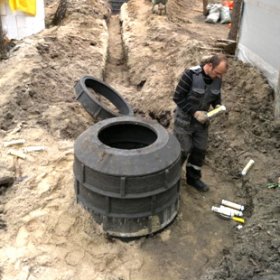
During the construction of a well, a person tries to choose the most resistant to natural factors material. Dampness, groundwater, along with chemicals, temperature changes, etc. affect the quality of the well tightness. And since it is quite difficult to repair it (especially sewer and drinking!), It is more profitable to buy more expensive material that has a long service life. A great alternative to traditional reinforced concrete structures is a polymer sand well, whose installation is cheaper, and durability and tightness are still beyond competition.
What are polymer sand wells made of?
The raw material for polymer sand wells is a composite material into which sand filler is added. Composites are varieties of plastic endowed with different properties depending on the additives that are mixed with them.
Wells are made by hot pressing, mixing powdered elements and exposure to high temperatures and pressure. As a result of sintering, the structure of the material is slightly porous and very strong.
Reinforced concrete and polymer sand: who wins?
For a long time, reinforced concrete remained the only material for the production of wells. But its properties are far from ideal. Compare them with similar characteristics of polymer-sand raw materials.
Weight and transportation to the facility
Reinforced concrete materials are significant in weight. A meter ring has a mass of about 500 kg, which means that for its transportation to a construction site, special equipment is needed both for loading and unloading (crane) and for transportation (truck). Even if this is found, such a bulky equipment is not always “squeezed” into the narrow space of the construction site, especially in the urban area, where residential buildings are nearby.
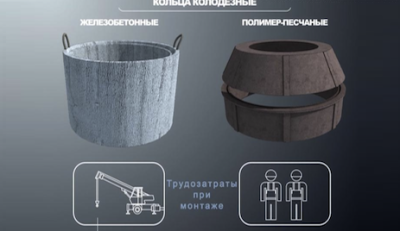
Due to the less voluminous components, polymer wells are easier to install, because large equipment is not needed and many workers

In diameter polymer sand wells are not thicker than 1.1 meters, so they can easily fit into a regular trailer for a car
In turn, polymer-sand wells are significantly lighter. The mass of any fragment of the structure (ring, hatch, etc.) is up to 60 kg. This weight will lift two people without using a crane. And the summer resident will be able to transport to the site an ordinary trailer for a car. Another plus: it is easily mounted in an inaccessible place (for example, in the basement), because the owner of the site can roll the rings and throw them into the mine.
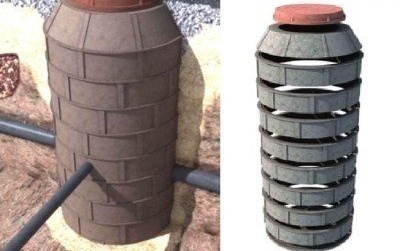
One person is able to assemble a whole well from the elements and mount it in the ground, because the weight of each element does not exceed 60 kg
Features of joining elements and tightness of joints
In reinforced concrete rings, the edges cannot be made absolutely even, so during installation you have to mess around a lot with tight joints.And all the same, over time they are washed away by water, as well as the walls. And if the well stands on moving ground, where groundwaters have very strong flows in the spring, then the rings can move, breaking at the joints.
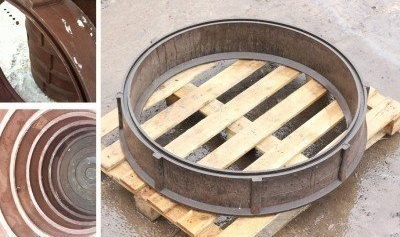
With the groove-comb system, both structural elements are connected as tightly as possible, so the joints do not require additional sealing, except silicone
Polymer-sand elements are joined according to the "groove-comb" system, due to which they are not afraid of soil movements. Such a connection absolutely does not allow water to pass through, and it is enough to cover all the grooves for insurance with silicone sealant or bitumen mastic.
Ability to resist moisture
Moisture is the main enemy of reinforced concrete structures. The concrete surface has large pores, and during the winter season frost from the earth penetrates into them, expands and causes microcracks, which will increase every year.
Due to the technology of "sintering" of particles, the level of water absorption in polymer-sand rings is only 0.03%. The well is able to withstand over five hundred cycles of freezing and thawing (from -65˚ to + 160˚C) without any disturbance in the structure.
Resistance to aggressive substances
Together with water from the soil, aggressive substances that destroy the structure of concrete get onto the surface of the wells, and if the well is sewage, then from within it will “spoil” the decomposition of biomass. To make these processes weaker, reinforced concrete rings are lubricated with special antiseptics and waterproofing mastics.
An aggressive environment is not afraid of a polymer product. Composite material does not react with substances, therefore it is not afraid of salts, acids and alkalis and does not require additional processing.
Easy to connect to the pipeline
When connecting a well with a home water supply system, it is necessary to drill holes or openings in it. In reinforced concrete, this is very difficult. Often a professional tool is required.
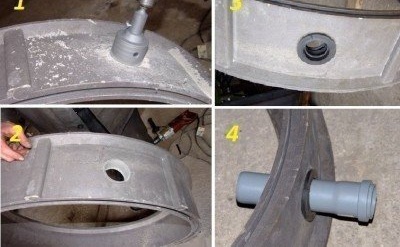
You can cut openings and holes for pipes in polymer sand wells with ordinary household tools, and you do not need to process the edges with anything
In the polymer ring, all openings are created with household tools. In this case, it is not necessary to lubricate the edges of the cut out piece with any compounds, because the plastic is not afraid of corrosion.
Warranty period
Manufacturers give a guarantee for reinforced concrete products for about 50 years, but indicate that these parameters relate only to the main technical characteristics. Those. the ring will definitely not fall apart and not become thin. But they can’t give a guarantee for the tightness of the joints, so even the most durable factory wells can become silted in a couple of years if the installation was carried out illiterate.
With polymer sand wells, such incidents are excluded. Therefore, manufacturers give a guarantee of up to 100 years, although plastics in nature decompose over 400 years, and the sand that is part of the raw material is eternal.
How is a polymer sand well constructed?
Like the reinforced concrete version, polymer sand wells are made up of separate rings. Each height is 200 cm. An adapter, similar to a cone, tapers upwards, which is covered with a hatch with a cover, is put on the last ring. In addition, for complete tightness of the container, a bottom 30 cm high is produced, which is attached to the ring with the same groove-comb system.
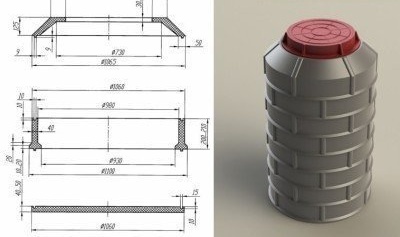
All elements of the polymer sand well are joined according to the groove-comb system, therefore during installation there are no problems with connecting the parts - everything is assembled as a designer
The deeper the well is needed, the greater the number of rings taken for its installation, although the standard design consists of: 8 rings + 1 adapter + sunroof with cover + bottom plate. The total weight of the folded product is about 600 kg.
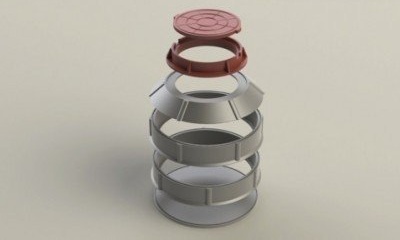
Polymer-sand wells are easier to install at great depths, since you can order and install any number of rings
Areas of application for polymer sand products
All existing types of wells can be created from polymer sand material. These include sewer, plumbing, shedding, drainage and viewing. Absolute dryness inside allows the use of such wells for telephone communications, power networks.
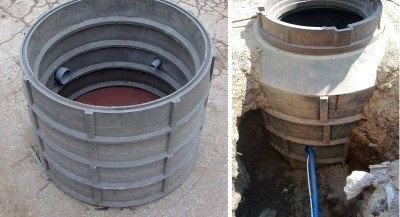
Polymer-sand wells are in demand when laying telephone lines and telecommunications, because they are dry, which means there is no danger for equipment damage
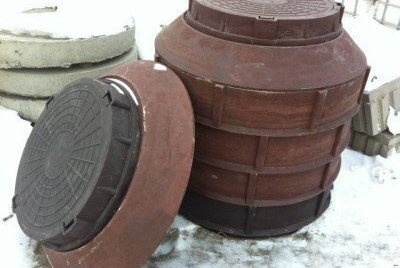
Polymer sand hatches are available in different colors, so you can choose the right option for coloring paving slabs so that it is invisible
A nice bonus: Manhole covers are of no interest to thieves who trade in scrap metal, because they lack metal elements.
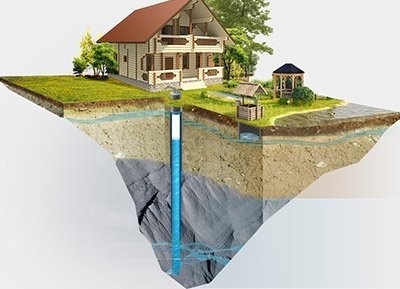
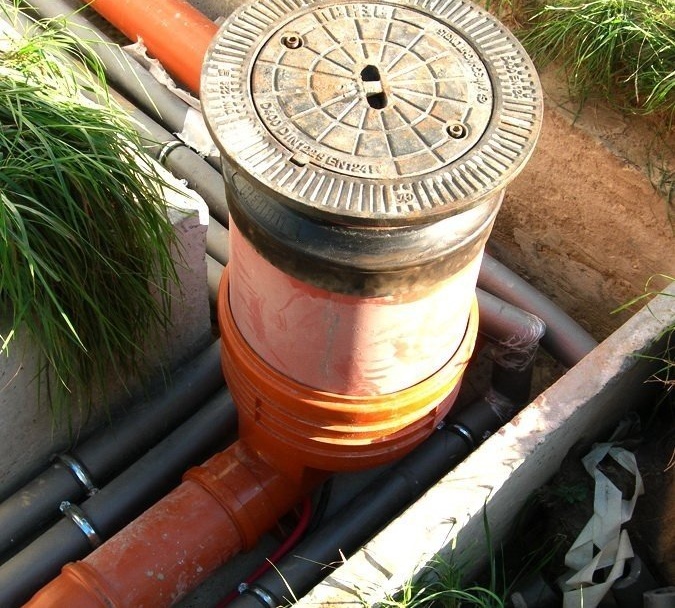

7 comments